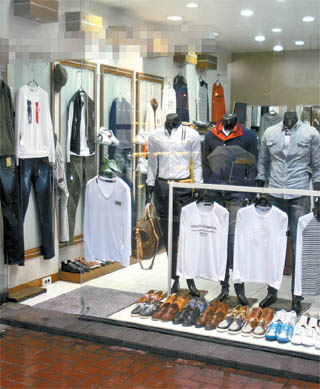Counterfeiters play safe and leave off the logos

A clothes store in Daegu selling a wide range of copied items. A white shirt on the mannequin in the center is identical to a design by Moncler, a high-end French fashion brand. By Gong Jeong-sik
“It has the exact same design and fabric,” the shop owner said. “The only thing it doesn’t have is the Chloe name or logo.”
A line of military-inspired footwear is on display at a shoe store in Dongseong-ro, downtown Daegu. The design is almost identical to that of this year’s spring/summer collection from Valentino, an Italian luxury house. But again, no labels can be found. Each pair sells for around 180,000 won, a good deal compared to Valentino’s more than 1 million won price.
But you won’t see the name Valentino on the shoes or its logo on the exterior. If that’s important to you, the owner has a compromise.
“If you need the logo, I can give you a couple separately,” he said. “You can stick them on later.”
Korea wouldn’t be the king of counterfeit luxury products - in quality, if not in bulk, which is a title held by China - if it didn’t keep up with trends. And the newest trend in the rip-off game is avoiding any labels or logos that identify luxury brands. The counterfeit manufacturers, wholesalers and retailers are safer that way.
Fake luxury goods without names or logos exploit a legal loophole. A knockoff bearing a logo or the name of a well-known designer infringes the copyright on a trademark. A rip-off without a label or logo infringes design rights. But the law for each is different. Infringement of copyrights on trademarks could lead to a jail term of up to three years or up to 30 million won in fines. The Design Protection Act is a different law, and there’s a grey area in determining whether a design is copied or not.
“We need to go through a complex legal process to determine design infringement in order to punish counterfeiters, even if we find a fashion item blatantly copied a luxury brand’s design,” said Jeong Jeong-jae, an employee of the division in charge of clamping down on knockoffs in the Jung District.
All 380,000 knockoff items detected by the Korean Intellectual Property Office over the past three years had logos of famous brands.
The loophole is really playing into the counterfeiters’ hands these days. Many luxury brands have cut back on logos because the public has become jaded with them. Sophisticated shoppers recognize a Louis Vuitton or Chanel product without a logo. But that makes it easier for the counterfeits to get away with ripping off the designs.
“In Japan, design infringement can immediately bring criminal punishment,” said Lee Jae-gi, an intellectual property expert at the Korean Apparel Industry Association. “The Park Geun-hye administration speaks a lot about a creative economy. But what we need to do is to value creativity and punish those who steal people’s creative ideas.”
BY KIM YOON-HO, PARK EUN-JEE [ejpark@joongang.co.kr]










with the Korea JoongAng Daily
To write comments, please log in to one of the accounts.
Standards Board Policy (0/250자)